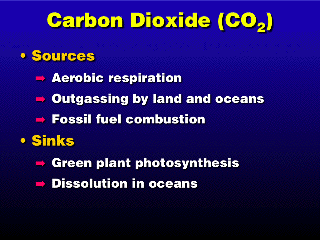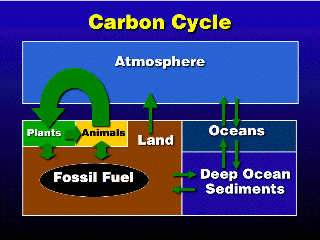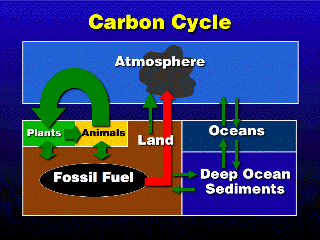

 |
 |
| "Natural" Carbon Cycle | Anthropogenic contribution to atmospheric carbon |
The largest amount of CO2 transferred in the carbon cycle is the atmosphere-biosphere (green plants-animals) exchange. [The illustration has been corrected from the one shown in lecture to reflect the relative amounts of carbon flowing in the pathways shown.]
A significant, though small, exchange occurs between the oceans and the atmosphere (the dark green arrows), not including the ocean biosphere (plankton). The carbon become buried in the Earth's crust as it settles out in sediments of carbonate compounds, then is eventually emitted as CO2 through outgassing, such as volcanic eruptions. This cycle takes thousands or millions of years for the carbon to move through.
Fossil fuel is carbon that was once plant and animal life millions of years ago, and was buried and transformed to coal (elemental carbon), crude oil (complex hydrocarbon), and natural gas (CH4).
Pulling fossil fuel out of the ground
and burning it releases carbon dioxide to the air much more rapidly than would
have happened naturally (the normal cycle would be on the order of millions
of years). And, the natural environment does not have a sink rate large enough
to handle this extra CO2 load (the natural sinks will normally take care of
only the "natural" CO2 sources, mainly from respiration). The additional
burden of CO2 to the atmosphere has caused the accumulation of CO2 since the
beginning of the Industrial Revolution.
 The largest anthropogenic source of CO2 is fossil fuel combustion,
mainly from coal combustion in electric power generation and from transportation
(automobiles). Deforestation indirectly increases atmospheric CO2 by
decreasing the sink for CO2 (green plants).
The largest anthropogenic source of CO2 is fossil fuel combustion,
mainly from coal combustion in electric power generation and from transportation
(automobiles). Deforestation indirectly increases atmospheric CO2 by
decreasing the sink for CO2 (green plants).
Cement has a high carbonate
content. When mining the cement out of the ground and grinding it into a powder,
the cement material heats up (the pressure of the grinding process raises the
temperature), which causes the carbonates to release CO2 into the atmosphere.